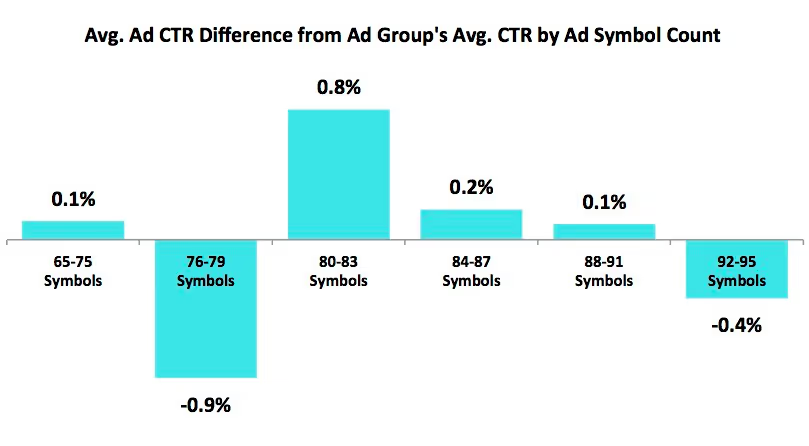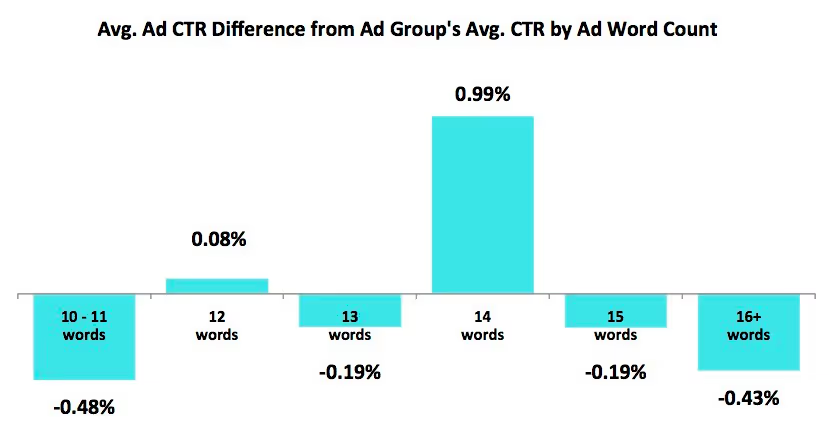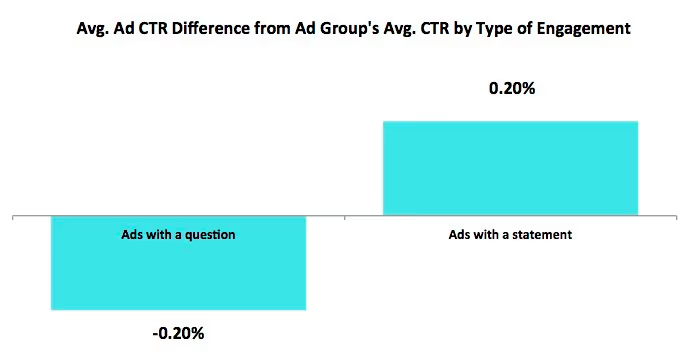.avif)
Having spent more than seven years in digital marketing we can firmly state that we've had our fair share of encounters with all kinds of online ads – good, bad, interesting, weird, bold, short and straightforward, long and informative, stats-heavy and so on. We ourselves have contributed to this variety as well. To help us figure out what works best, we decided to dissect various types of ads, analyze them and see how they perform against different key features. We’re excited to share the results with you. We think they will clear up some incorrect assumptions you may be making about what it takes to write a compelling Adwords ad.
Digital marketers make a lot of assumptions about how an ad should look if it is going to achieve a maximum interaction rate. To determine whether these assumptions hold up when put to the test, we took a sample of 262 AdWords ads and measured their performance over five years. We then compared the data with a list of common assumptions that digital marketers make regarding how to write good ads.
Surprisingly, four popular assumptions turned out to be untrue. We’ll break down each one a little later, but first, we want to clarify that we consider an ad to be better in terms of performance if its click-through rate (CTR) is higher than that ad group's average CTR.
Another quick disclaimer – while there are definitely areas where the following findings do not apply, still – they suggest what works on average. Note, that we excluded marginal ad cases, like discounts and special offers to prevent result bias for obvious reasons.
Dan Shewman from WordStream briefly covers this topic, advising you to be as descriptive as you can while not using unnecessary words or characters for its own sake. We would like to go even further here and elaborate more in depth on this.
Note that here we consider all the permissible symbols in a standard AdWords text ad. That is, a headline can have up to 25 symbols and both description boxes can have up to 35, which totals 95 permissible symbols.
So, a frequent thought that crosses ad writers' minds is: "Ok, so, I've inserted the main ad text, told everything that I wanted to say, and I'm still left with 15 symbols. I should include a few more words, to say even more!"
This is not the best approach to creating ads though. As we can see from the graph below, the best CTR results were achieved when ads contained a 'reasonable' amount of symbols in them. In our case it was somewhere around 80 to 85.

So, while it's a gamble trying to come up with short and good ads, writing long ads on average is a bad practice.
A good takeaway here is to not overload your ads – communicate your main idea and information with as little text/symbols as possible, while still sharing the core concept. Also, try to make your ad easy-to-read at first glance. This example illustrates exactly what we mean:
Let's assume we sell coffee mugs online. We could come up with an ad that looks like this:

However, a more appealing ad would be:

Notice that we not only reduced the amount of symbols, but we also cut the amount of words by merging the first two similar offers in the description and improving the wording and style of the ad.
The more appealing ad is easier for your target audience to read because it feels 'light' (like a good book). You can accomplish this lighthearted approach by not using too many words that add unnecessary weight. Try selecting simple, but informative and powerful words. The performance results support this approach:

A good rule of thumb: limit the amount of things you offer in your ads (1 to 2, instead of 3+) with a smart, short, and clear message.
Firstly, we would like to make something clear – using numbers and stats in ads can be very advantageous. We have no doubt here. Whether it be for the purpose of promoting your extensive product selection or emphasizing that you are in business for a long time. You might know or have read this statement somewhere online. For example, the guys over at Unbounce, The Daily Egg as well as at the previously mentioned WordStream show and explain this quite comprehensively. However, we felt that the other side of the story was missing with their statements, i.e. – what about when you use a lot of numbers in ads?
You have most likely seen an ad that contained a lot of digits. Did it get you wondering about the excessive attempt at credibility in the ad? Did the ad seem to come on too strong? Or, did you find the ad difficult to process in general? Well, we’ve thought these same things. Something about them just doesn’t feel right. After checking the results, we discovered this:

Ads with few digits in them did tend to be superior, but when the amount of digits rose, the ads quickly dropped down in terms of performance.
A good example of an ad that uses too many numbers is the following. Imagine we supply safes to businesses and homeowners for physical storage of documents, valuable belongings, bearer bonds or cash. We could approach our potential prospect in this manner:

This ad takes time to process and feels like not much of value is being said. To fix this, you should choose the one thing that is most important. In this case there are three possibilities to choose from: 1) the extensive selection of designs available 2) the amount of clients served to emphasize trust or 3) the fact that you are in business for a long time. Let’s say you choose the first possibility. A good modification of this ad would be:

Additionally, it is also a good idea to test rounded up numbers, numerals and prefix abbreviations (e.g. 7 thousand, 7k, 10 million).
For the sake of clarity, we identified and analyzed only the “real” adjectives, like: exclusive, fast, reliable, flexible, comprehensive, reasonable, convenient, etc. We excluded marginal cases (e.g. the best, cheapest, guaranteed) for the same result bias reasons.
It's not a rare occasion in our field that we come across an ad promoting a service or product like this: "Fast, Convenient & Reliable". We call these ads “shallow praises”. You automatically know something is wrong (or at least odd) when an ad speaks to you through adjectives more than through a clear offer, strong call-to-action or information. Thus, the results here did not surprise us:

Consider this real-life data storage service ad that we came across on Google about Google:

Let's focus on the first three words in the description – Safe, Secure & Flexible. Firstly, wouldn't we expect apriori our data to be stored safely via any legit provider out there? Secondly, don’t “safe” and “secure” adjectives speak to us about the same thing? Finally, what does the ad mean by “flexible”? Is that access to data on demand or data management online? Does it cover unlimited uploads and downloads? We have no way of knowing because the ad is too vague. Therefore, instead of the first sentence in the ad, which does not offer us much, it would be wise, for example, to simply explain the services not via hollow and superficial adjectives, but in an objective manner (e.g. “archiving, back-up & disaster recovery” or “low latency for frequent access”). Take a look at this ad as a good modification to the one above:

A really good read about marketing is Guerrilla Marketing by Jay Conrad, Jeannie & Amy Levisons. We really like the advice given particularly about using adjectives and adverbs in ads – don't use too many adjectives, but do use a lot of facts and when you are left only with pure facts, remember quality and pepper these facts with adjectives to create a desire to buy.
To sum up, a good takeaway here is to restrain from praising your service/product shallowly and too much. Stick to an objective and informative ad with a max of two main adjectives (qualities), that clients will have as side bonuses if they purchase your product or service.
The main idea behind this approach is to engage an audience with a question, whether it be through the headline or through the description. This way, an ad is trying to grab a person's attention in a more aggressive, interactional, and straightforward manner.
In our analysis, we got on average a lower CTR by -0.2% vs. the average CTR level of that ad group:

Though, a more interesting observation here is that most of the ads with questions underperformed just slightly, but the few that outperformed did so more than slightly. This means two things:
Thus, aiming for the long run, we advise to rely more on statements rather than questions, unless you are a king of knowing what and how to ask, then you will benefit immensely.
We will share and visualize this with two of our own examples of how we tried to engage our probable clients via Google's search. At first, we tried this route:

But then we shifted from this approach and released this ad with better results:

Not to deliver the wrong message – we strongly believe you should test different and unorthodox ad messages. That’s how knowledge and valuable experience is gained.
However, our goal with this article is to provide a helpful resource for the beginner and experienced marketer alike who may be wondering, like we were, about ads, their design, messages, assumptions about what works and long-term performance.
Certainly, there are a lot more ad features we could analyze, but we’ll leave that undertaking for another day.
Did we bust any of your assumptions about writing effective AdWords ads? We’d love to hear which of the four assumptions you’re surprised made our list.